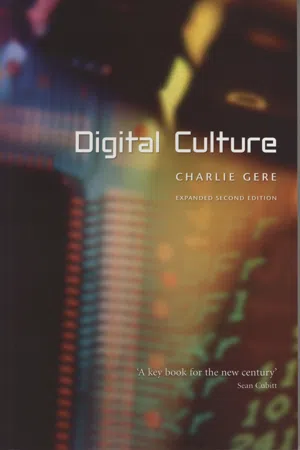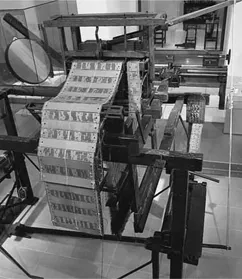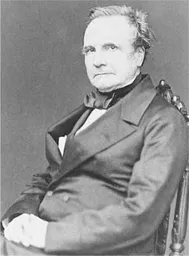![]()
1. The Beginnings of Digital Culture
TURING’S CONCEPTUAL MACHINE
In the late 1930s Alan Turing, a fellow of King’s College, Cambridge, published a paper entitled ‘On Computable Numbers with Application to the Entscheidungsproblem’.1 It was a response to part of one of a number of proposals by the German mathematician David Hilbert. Hilbert wished to cast all mathematics in an axiomatic structure, using the ideas of set theory. From the beginning of the twentieth century on, he proposed a number of programmes that would achieve his aim. In the 1920s he put forward his most ambitious of these programmes, in which all mathematics was to be put into an axiomatic form, the rules of inference to be only those of elementary logic. He proposed that a satisfactory system would be one which was consistent, in that it would be impossible to derive both a statement and its negation, complete, in that every properly written statement should be such that either it or its negation should be derivable from the axioms, and decidable, in that any statement or its negation should be provable by an algorithm. The completeness part of this programme was shown to be unworkable by the German mathematician Kurt Gödel who, in 1931, demonstrated that there was no system of the type Hilbert proposed in which integers could be defined and which was both consistent and complete. The impact of this discovery, which is known as ‘Gödel’s incompleteness theorem’, was great and its importance goes beyond mathematics to encompass broader questions of systems and systemization. The decidability part of the programme was also undermined by the simultaneous work of Gödel and Turing. In order to approach the question Turing imagined an entirely conceptual machine, which could be configured to be in a number of different states. He based this idea on the typewriter, which can be configured to write in either upper or lower case. The difference was that Turing’s machine could be configured in an infinite number of states. He also imagined his machine having a writing head, like a typewriter key, which could write and erase marks on an infinite tape. The tape would contain spaces that were either marked or blank. The writing head could move up and down the tape in either direction. It could also read whether the space on the position contained a mark or was blank. The machine could be configured to undertake a number of different actions according to what it found. With the appropriate configuration almost any mathematical problem could be solved, but certain problems were effectively unsolvable with such mechanical processes. By devising his universal machine Turing proved that mathematics was not decidable. Turing’s virtual machine worked for him inasmuch as, as a kind of philosophical toy, it enabled him to conceptualize and solve the problem with which he was concerned. He also went some way in conceptualizing the modern computer, by positing a binary machine that could be configured in any number of different states.2 Turing was able to use his purely theoretical ideas about calculating machines during the War when he developed methods and technologies for decrypting German U-Boat signals. This work in turn led to some of the first modern electronic binary digital computers. Turing’s Entscheidungsproblem paper is widely regarded as one of the first conceptualizations of such machines, and one of the keystones of the development of digital technology. But it is fascinating as much for the past to which it alludes, albeit unconsciously, as for the future it anticipates. In a sense it contains, in minutiae, many of the elements from which digital technology and digital culture developed.
Turing’s thought experiment is of particular importance for the development of modern computers in that it was intended to be a universal machine. Though a number of electronic calculators had been produced these were mostly dedicated devices, capable only of specific hardwired operations. In contrast, Turing’s imaginary device was, in theory at least, able to be programmed to undertake any mathematical problem. The idea of a universal machine had already been imagined by predecessors such as Charles Babbage and Ada Lovelace, and work by George Stibitz, Konrad Zuse and Claude Shannon and others made its practical realization more feasible, but Turing’s particular vision had a conceptual coherence lacking before. As mentioned before, Turing was able to conceive of the idea of the universal machine through the example of the typewriter, which can be configured in two different states, upper and lower case, using the same keyboard. On one level Turing’s use of the typewriter was merely expedient: it was a readily available tool that Turing himself used, albeit erratically.3 He was undoubtedly concerned simply to find some device that could act as a model in conceptualizing a solution to the problem he was addressing. It is almost certain that Turing had little interest in the social and cultural implications of his choice. Yet the technology he chose, and that was so readily available to him, was in fact deeply embedded in a network of social and cultural meaning, one derived from contemporary capitalism. Thus it is possible to see how capitalism offered the context in which the computer could develop.
THE DIVISION AND ABSTRACTION OF LABOUR AND CAPITAL
Invented in the late nineteenth century, as a response to the burgeoning information needs of business, the typewriter standardizes and mechanizes the production of language, reducing the elements out of which it is composed to abstracted signs (illus. 1).4 In this it is a paradigmatic product of the system in which it was developed. Like the typewriter and, by extension, Turing’s device, the operations of capitalism are fundamentally predicated on abstraction, standardization and mechanization, to ensure that it can operate as a universal machine, capable of treating disparate phenomena as equal and interchangeable. This is found in its emphasis on the exchange value of commodities, rather than their use value, the introduction of credit, paper money, and ‘fiduciary’ money, the division of labour into discrete and repeatable parts, and the standardization of components. This abstraction enables the flow of goods, money, and people crucial to capitalism’s continuous quest for expansion and profit. It also allows for the integration of machinic assemblages, including physical machinery, such as the steam engines and spinning jennys of the early nineteenth century, and factories, in which workers were bound to machines and their work is regulated like machine-like processes. One result of this is that under capitalism signification is no longer anchored to stable, embodied meanings. Goods are no longer valued for their material and embodied usefulness, but instead for their exchange value. The value of money no longer refers to its intrinsic worth as metal, or what it might represent in stocks of gold. Wealth is in liquid form rather than tied to ownership of land. The complex web of feudal social relations is replaced by the ‘cash nexus’. Workers are regarded as abstract labour power. Thus signification itself becomes autonomous, and signifiers move independently from the world of material objects. As Karl Marx analysed in the first section of Das Kapital, the commodity is at the heart of capitalism’s capacity to operate in abstract terms. Marx shows how, in order to be circulated, commodities have to be considered in terms of their exchange value. This is a form of ‘semiotization’ in that the commodity’s physical and material character ceases to be of account in relation to its capacity to circulate, as a sign, within a capitalist society.5 As long as a commodity is circulating thus it can be considered in terms of its comparative value against other commodities. Labour too is considered a commodity in that it too is exchanged for money.
1 A Remington typewriter, after 1874.
Turing’s imaginary device not only invokes the typewriter, one of the paradigmatic information technologies of nineteenth-century capitalism, but also, in the tape and writing head assemblage, the very model of the assembly line. Moreover, the algorithmic method which his machine was intended to automate is itself a model of the division of labour, which, as both Adam Smith and, later, Marx realized, lies at the heart of efficient capitalist production. Smith begins The Wealth of Nations with his famous description of the manufacture of pins, an operation divided, according to Smith, into eighteen different parts, each of which can be undertaken by a separate labourer.6 In this manner a far greater number of pins can be produced per person than if one worker undertook the whole process of manufacture for each pin. The division of labour also allows each individual action to become a repeatable and interchangeable sign. Codified in this manner, the operations of production can be more easily understood and controlled. This can help reduce reliance on expensive skilled labour, and living labour altogether.
2 A Jacquard silk-weaving hand-loom, the first machine to use punched-card programming, 1810.
This can be seen in one of the first (and most celebrated) examples of automation, in which the division of labour was embodied in a machine (illus. 2). Joseph-Marie Jacquard’s pattern-weaving loom of 1804 controlled the lifting of each of the warp threads for each pass of the shuttle through a system of wooden cards punched with holes. The actions of the human weaver were codified and converted into marks on the wooden card, which were then ‘read’ by the machine in order to repeat them. The Jacquard Loom can be understood as an early attempt to reduce the costs and difficulties of employing living labour, by embodying the labour process in fixed capital. Though embedded in an artisanal paradigm, it anticipates not only automation but the whole development of labour management in which workers’ actions become discrete and interchangeable, and in which individual skill ceases to be of account.
One of the first theoreticians of labour management was the mathematician Charles Babbage (illus. 3). In a number of works, studying the postal system, the railways, and especially in his On the Economy of Machinery and Manufactures,7 Babbage examined ways of making manufacturing efficient, economic and rational. Following the work of Smith he promulgated the economic advantages of the division of labour, as well as the increased use of machinery in manufacturing. This directly inspired the work for which he is now most famous, his development of early computing machines. From 1822 right up to his death in 1871 Babbage was engaged in building, or trying to build, machines, the ‘Difference’ and ‘Analytical’ engines (illus. 4), that are recognizably prototypical computers. His initial reasons for building the ‘Difference Engine’ concerned the efficient production of mathematical tables, used both at sea and in industrial production. Babbage had come across the table-making project of Baron Gaspard de Prony in France, which had employed the division of labour advocated by Smith in The Wealth of Nations. Prony had divided the work of generating such tables into a number of small simple tasks distributed among many human ‘computers’. Babbage realized that this technique could be automated and persuaded the government to fund the Difference Engine, which was comparatively simple, being intended only to calculate and print out such tables. The second, the ‘Analytical Engine’, had it been completed, would have been programmable, and able to calculate any formula, and to compare numbers and decide how to proceed with the operation it was performing. The engines were modelled on industrial machinery and built using the same techniques. But they also invoked the newly emerging digital technologies of control. Babbage intended employing the punched cards used by Jacquard in his loom as a method of programming his Analytical Engine. What Babbage hoped to achieve for his Analytical Engine is less extraordinary than some of the ideas of his colleague Ada Lovelace (illus. 5). She remarked that the Analytical Engine ‘can arrange and combine its numerical quantities exactly as if they were letters or other general symbols’. She also suggested that the engine might compose elaborate and scientific pieces of music of ‘any degree of complexity or extent’. Remarking on the use of punched cards as used in the Jacquard Loom she wrote ‘We may say most aptly that the Analytical Engine weaves algebraical patterns just as the Jacquard-loom weaves flowers and leaves’.8 Though Babbage did not think of employing his engines in pursuit of efficient manufacturing, he embodied a link between calculating machinery and rational industrial management that has never since been broken. Both his calculating machines and his management theories were responses to burgeoning capitalism, which was producing the need for ways of dealing with ever-greater amounts of information, and for more efficient and rational ways of producing profits. These twin needs, information processing and rationalization, have permanently linked the development of calculating machinery with the development of modern capitalism, in all its protean forms. Indeed one might argue that, though manufacturing processes did not generally use machinery for control purposes until the twentieth century, processes of mass production and the division of labour clearly evolved within a paradigm of machine logic, one later developed by Frederick Taylor and Henry Ford.
3 The computer pioneer Charles Babbage (1791–1871) in 1860.
4 Charles Babbage’s Analytical Engine, 1871.
At a deeper level Babbage’s dream of a machine capable of responding without prompting from outside resembles the very basis of the market. As formulated by Adam Smith in The Wealth of Nations, this became the canonical expression of the ideology of classical capitalism. Central to Smith’s argument was the notion of the market as a self-regulating system. The Wealth of Nations can be, and has been, read as the description of a vast self-regulating machine, that of a free market, which with the minimum of state interference, relies on the famous ‘invisible hand’,9 which would lead to commodities finding their appropriate value. The computer-like nature of free-market capitalism led the historian Fernand Braudel to suggest that the ‘market’, the system by which goods are exchanged for money, was ‘the first computer mankind ever had, a self-regulating machine that would itself ensure the equilibrium of economic activities’.10 Such ideas were alrea...




